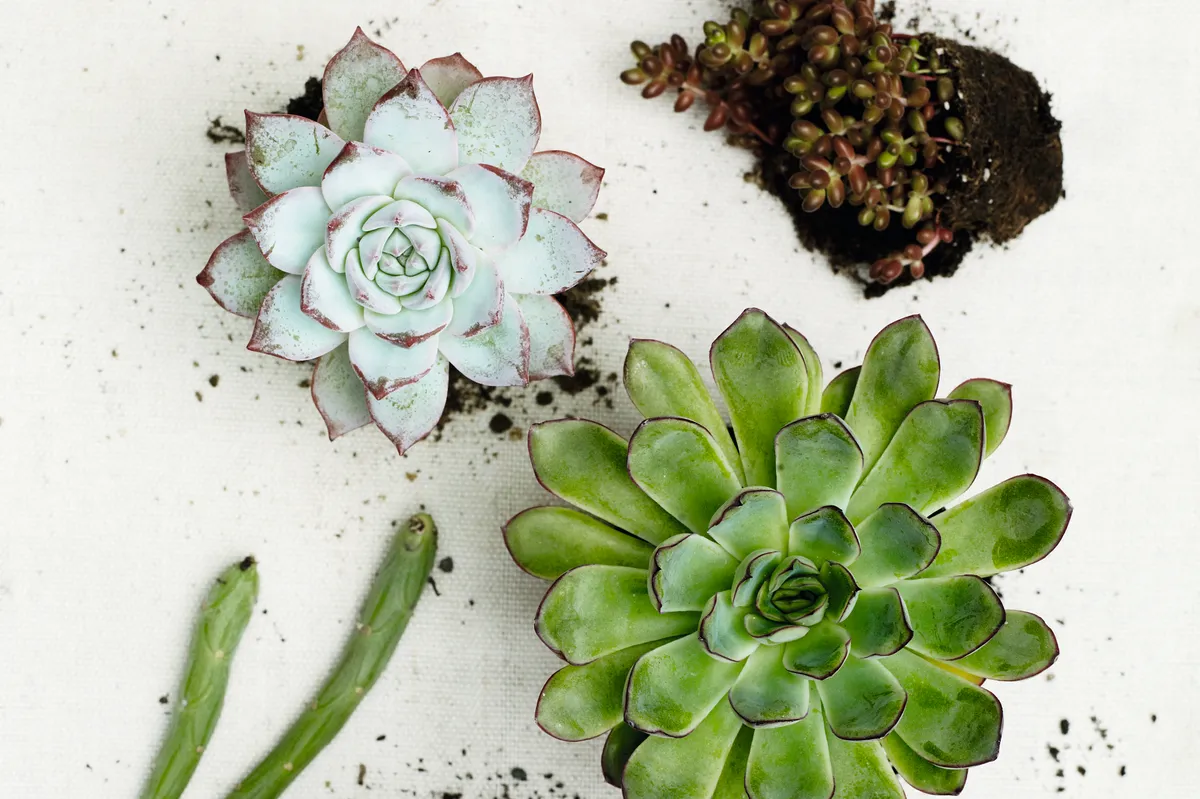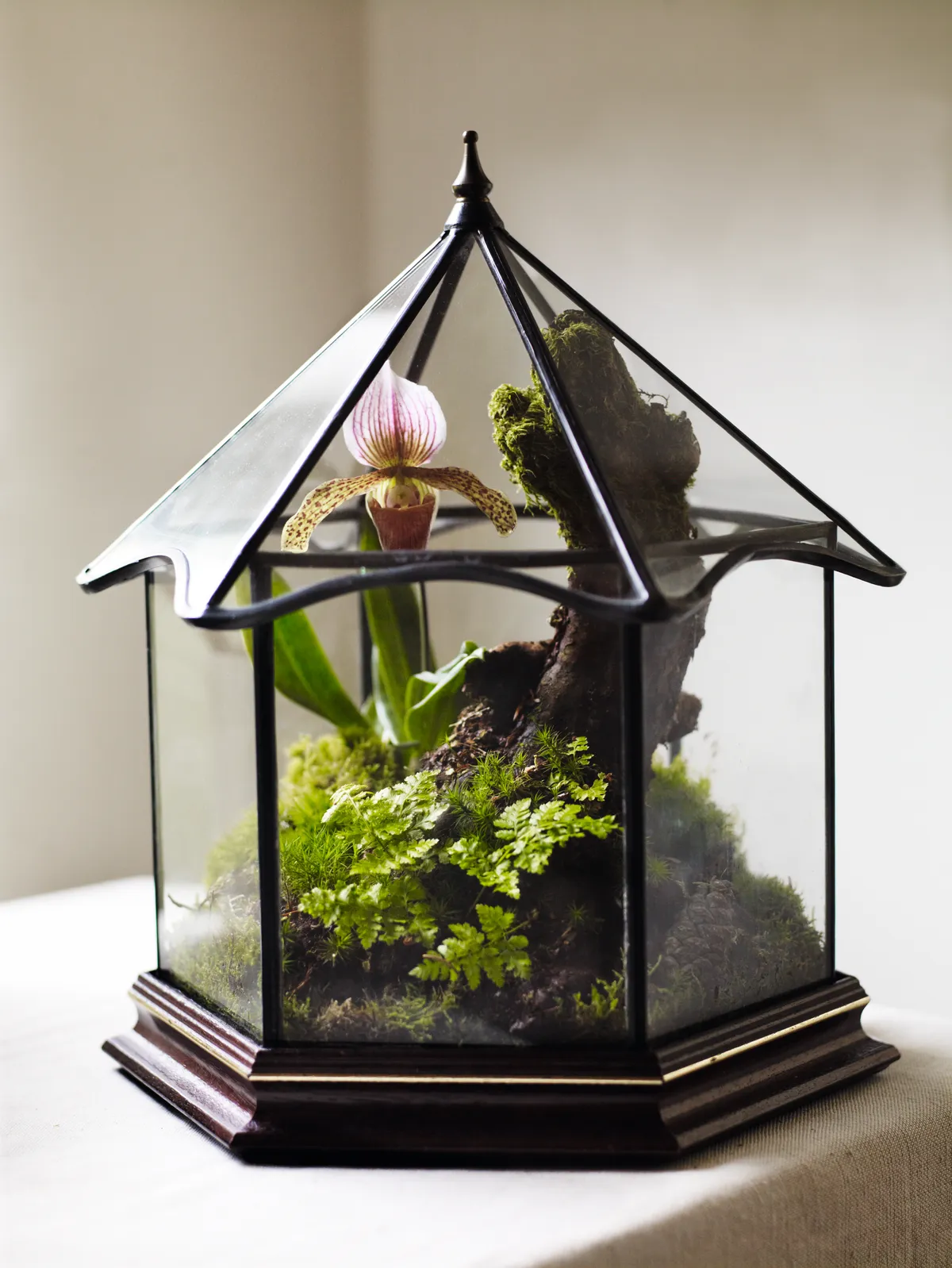Terrariums not only add a dynamic element to a room, but also create a tiny eco-system you can enjoy close up.
Take a look at our pick of the best terrariums to buy online to get you started.
Here's how to build and plant terrarium one of these miniature gardens in a glass dodecahedron. Plant enthusiast Ali Bell she says 'the geometric shape of this terrarium both magnifies and frames the symmetric forms of the Echeveria and other small sculptural succulents, whose intricate details are best appreciated close up.'
Ali also says that, 'although these water-retaining plants prefer hot, dry and well-drained conditions, they can thrive in a partly open terrarium, such as this one, in which the air is still able to circulate and keep humidity levels relatively low'. Read our piece on the history of terrariums.
How to plant a terrarium
Plants
The three Echeveria plants are the stars of the show. Tones of cool greens and blues are linked by the red accents on the leaves. The Sedum will colonise happily between the rocks and other plants, and the Senecio provides height at the back of the terrarium. When it grows too big I will replace it with smaller pieces. You should place the terrarium in a cool, bright room, avoiding direct sunlight, which risks glass magnifying the heat and scorching the fleshy leaves. Water these plants very sparingly, hardly at all in winter, and once every two weeks in summer if required.
- Senecio articulatus
- Echeveria colorata
- Sedum album ‘Coral Carpet’
- Echeveria pulidonis
- Echeveria nodulosa ‘Painted Beauty’

Materials
To create a terrarium you’ll need:
- Pebbles for drainage, ideally around 1cm in diameter.
- Activated charcoal. Mix in a handful with your pebbles to keep the eco-system sweet and avoid any stagnation and fungi that can occur when there is a lack of drainage.
- Soil, to suit your choice of plants.
- Moss or gravel to dress. As you’ll probably need to use sphagnum, pincushion and sheet moss in fairly large quantities, it is best to buy them from a specialist supplier.
- Natural objects found in your garden to enhance planting ideas.

Planting process
Start by putting 2.5cm-layer of pebbles for drainage, mixed in with a handful of activated charcoal into the base of your chosen container. It’s much easier to work out your plant combinations on the table first before planting as you have more room for manoeuvre. After you’ve decided on a design, start placing them in the terrarium. As this container had an opening at the front I planted it up from the back to the front so as not to damage or bruise the plants.
The easiest way to plant in a confined space like this – and to some degree all terrariums – is to use a long-handled spoon to place soil around them. After dressing with gravel I placed some stones I had collected to match tonally around the plants to make it look more like the plant’s natural environment. Finally, I used a paintbrush to remove any soil or gravel that had been spilled.
More ideas for planting a terrarium
Bell jar beauty
Bell jar cloches provide the most sealed-off and humid environments of all terrariums. It creates the perfect growing conditions for subtropical plants like this Streptocarpus 'Polka-Dot Purple'. Team it up with the simple, delicate foliage of Geranium robertianum and pin cushion moss like Leucobryum glaucoma and you have a beautiful natural-looking indoor display.

Victorian style
A modern-day nod to the Warden cases used by Victorian plant hunters for transporting exotic treasures. This lovely terrarium has been planted up with a tropical version of the lady's slipper orchid, Paphiopedilum sukhakulii x charlesworthii, a young Dryopteris filix-mas and a small amount of Polytrichum commune, a moss with a starry appearance.

Terrarium tools
For displays like this you'll need:
- A homemade tamper for firming in plants – a chopstick with a cork on the one end is perfect.
- Long-handled wooden salad spoon and fork to use as a trowel and for evening out soil or raking gravel
- Large wooden spoon, wrapped in kitchen roll, to clean around edges of terrarium after planting
- Large wooden knitting needles for making smaller holes or moving plants around
- Long tweezers or tongs for placing stones or rocks
- Scissors for maintaining plants
- Fish fork for removing moss from your garden
- Paintbrush to remove spilled soil
Recommended suppliers
PLEASE NOTE
Never take any plants from the wild. All mosses shown came from the author's garden or were bought as cultivated moss.